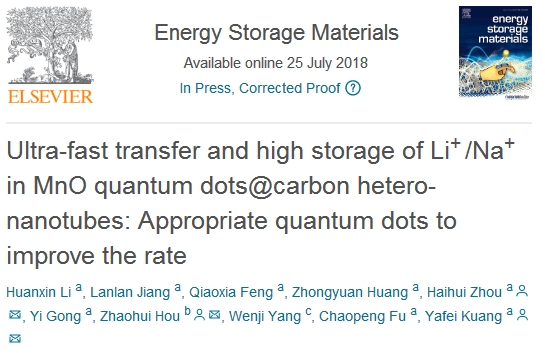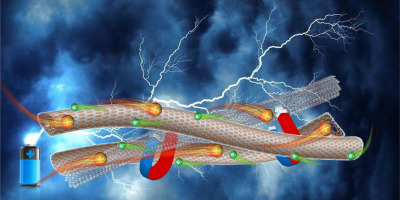Search Product
Structure Search
Search
Advantage Products
Location: Industrial Info
Nanotechnology helps lithium battery to achieve fast charging
2018-08-17
来源:转载自第三方
17 August 2018
Recently, researchers at Hunan University have synthesized a thick-walled carbon nanotube with uniform MnO nanoparticles embedded by molecular beam template method for the first time. When it used as a negative electrode material, the capacity and rate performance of the lithium ion battery can be greatly improved. The research results were published in the well-known journal Energy Storage Materials in an article entitled "Ultra-Fast Transfer and High Storage of Li+/Na+ in MnO Quantum Dots@Carbon Hetero-Nanotubes: Appropriate Quantum Dots to Improve the Rate" [1].

Under the guidance of policies, new energy vehicles have been showing a rapid development trend, and lithium-ion batteries, as the key to new energy vehicle technology, have been booming. The anode materials of lithium ion batteries are mainly carbon materials and non-carbon materials, and the carbon materials can be further divided into graphite carbon materials and amorphous carbon materials. As a main anode material, graphite anodes have been widely used, but their capacity and rate performance are difficult to meet the increasing demand. In recent years, more and more oxides and multimetal oxides have been used in anode materials for lithium ion batteries, but they are actively swellable during cycling. How can the lithium ion battery anode material be satisfactory in both capacity and rate performance? Nanotechnology may bring new technological breakthroughs.
In this study, scientists designed a new composite (MnOQD@CHNTs) by molecular beam template method. The introduction of MnO quantum dots greatly improves the structure and properties of the material:
- Structurally: a large amount of MnOQD embedded in the wall of carbon nanotubes can expand the carbon layer spacing, reduce the order degree, form a heterojunction with carbon, and change the local electron cloud density of carbon;
- In terms of properties: the capacity is greatly improved – after the introduction of MnO quantum dots, it has a great improvement on the adsorption of Li+/Na+ cations; the rate performance is improved – the intervening of MnO quantum dots increases the layer of carbon layers. The spacing reduces the migration energy barrier of ions between the carbon layers, and is beneficial to increasing the migration rate of ions, thereby improving the rate performance.

The test results show that at a very high current density (50A/g), the specific capacity can be stably maintained at 392.8 mAh/g after 100 cycles, and ultra-fast charging of 28.3 s can be achieved. If a mobile phone can really charge for 28 seconds, standby for a whole day, it will be very popular. We look forward to the arrival of this day!
Reference
[1] Huanxin Li, Lanlan Jiang, Qiaoxia Feng, et al. Ultra-Fast Transfer and High Storage of Li+/Na+ in MnO Quantum Dots@Carbon Hetero-Nanotubes: Appropriate Quantum Dots to Improve the Rate, Energy Storage Materials, DOI:10.1016/j.ensm.2018.07.021
Edited by Suzhou Yacoo Science Co., Ltd.
如果涉及转载授权,请联系我们。












